| |
|
|
| |
The International Maritime
Museum Collection, Hamburg
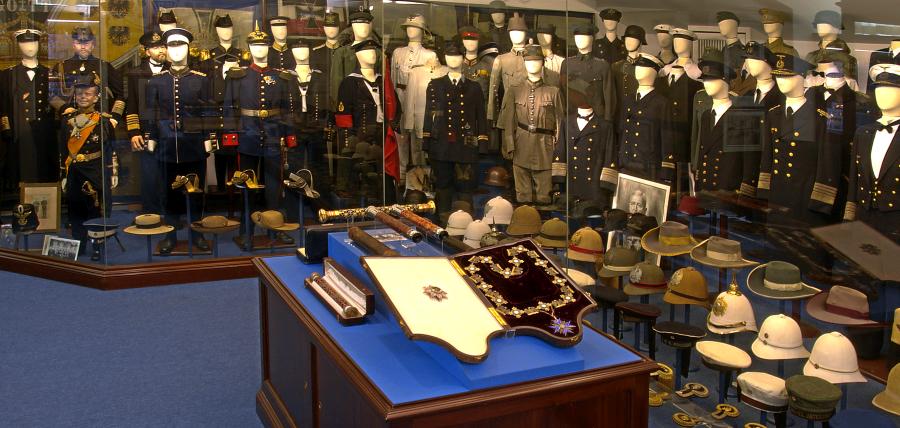
|
|
| |
|
|
| |
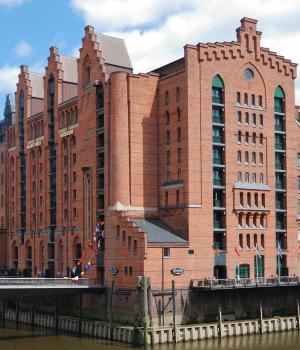 |
The International Maritime Museum in Hamburg has a
very interesting and varied collection over nine stories covering as
the title of the museum says international naval history over the
centuries.
Of special interest to us is the truly amazing collection of
Imperial German naval, colonial and East Asian headdress. Included
in it are such rarities as a Schutztruppe general's Südwester, a
South West African Landespolizei tropical helmet, an early Prussian
Seebataillon Tschako, a unique Schwarzburg-Sonderhausen East Asian
officer's straw hat and
what is probably the only surviving Austro-Hungarian army cap from
the Marine Detachment Skutari. The photographs of the collection
were taken by
Mark Schellenberg in 2016. Many of the items are
also photographed and described in detail in "The German Colonial Troops 1889-1918" by
Jürgen Kraus and
Thomas Müller, published
by Verlag Militaria.
I would highly recommend a visit to this amazing
museum which can be found at:
Internationales Maritimes Museum Hamburg
Koreastraße 1,
20457 Hamburg,
Germany
The official website for the Museum is at-
IMM-Hamburg.de
|
|
|
| |
|
|
Display of German
Colonial Headdress at the Internationales Maritimes Museum
Photos by
Mark Schellenberg 2016
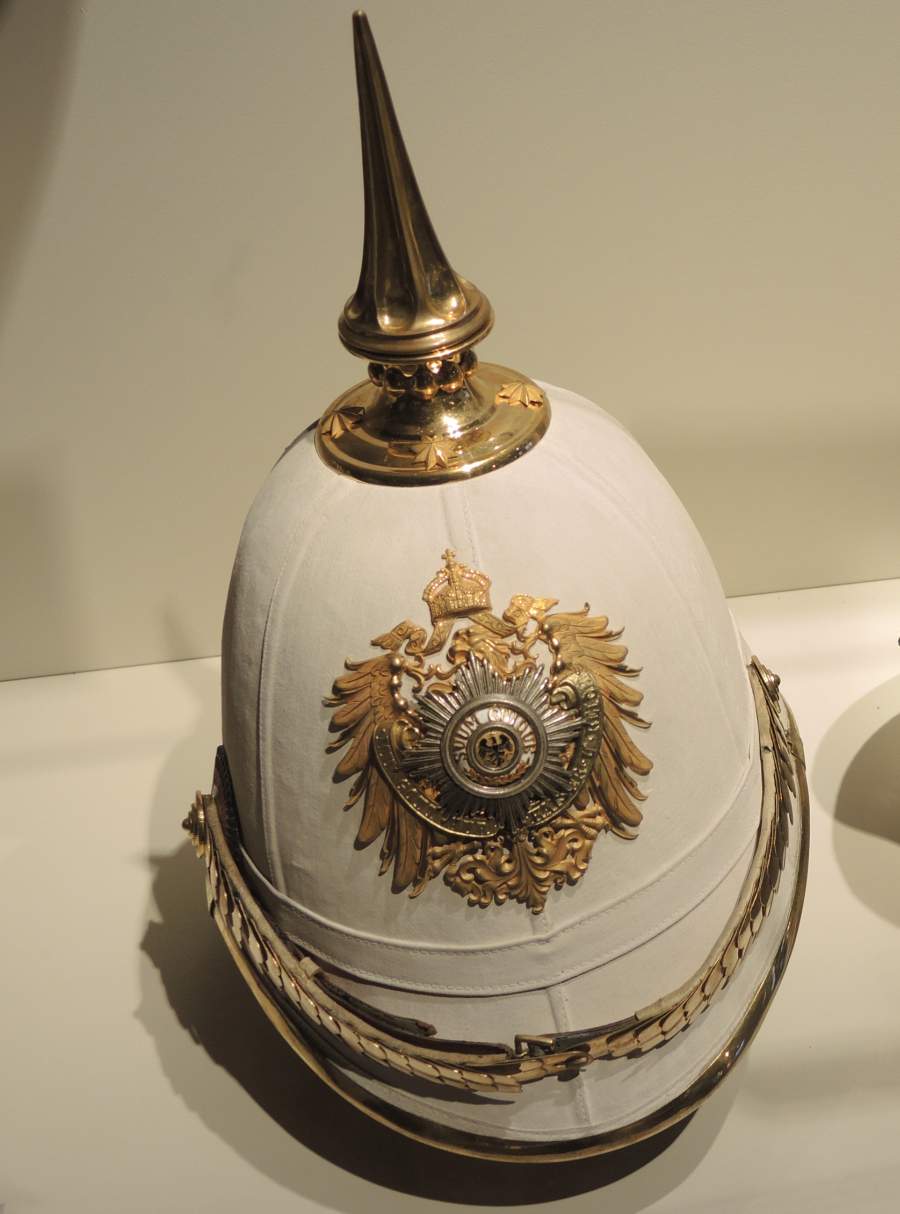
Tropical Helmet for a Colonial Governor
The helmet is of the 1891 Schutztruppe
pattern in cork covered with white cloth. It has brass edging, chin
scales and spike. It has a gold plated imperial eagle on the front
bearing the Prussian Order of the Black Eagle star.
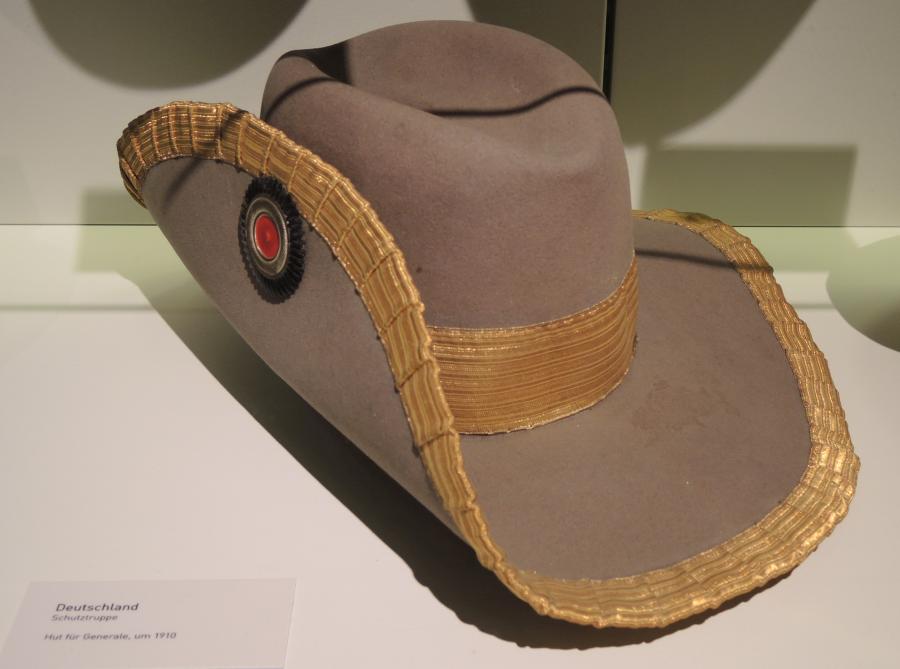
Südwester Hat for a Schutztruppe General
It has an officers cockade on the side and General's gold lace edging and
hatband.
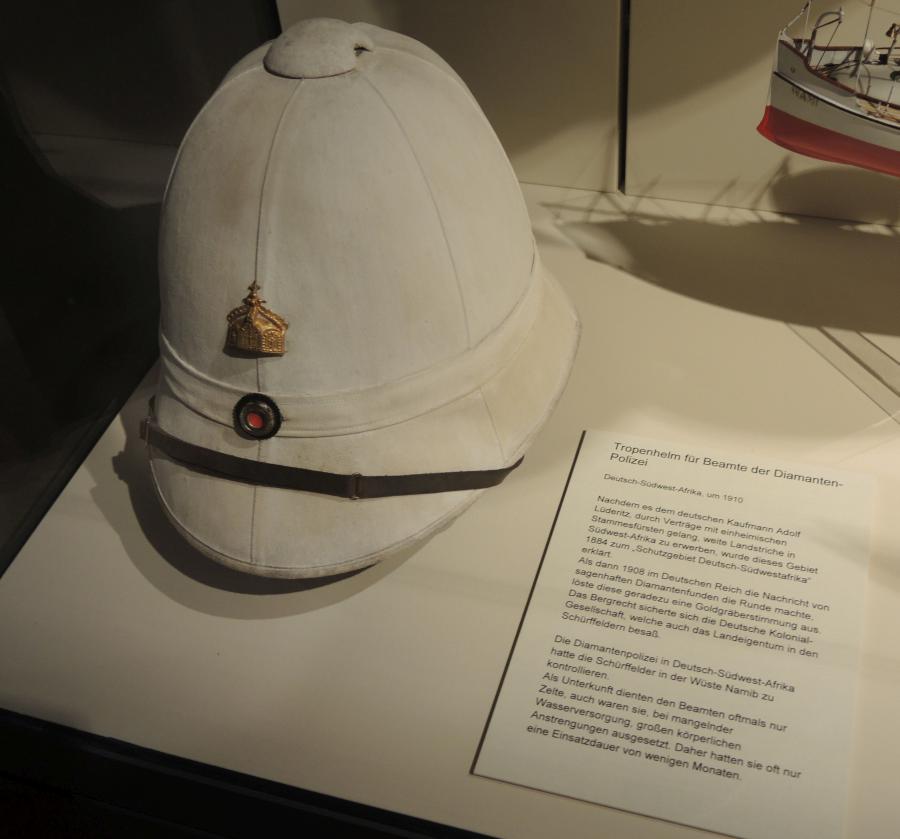
Landespolizei Tropical Helmet
The helmet is of the 1891 Schutztruppe pattern in cork covered with
white cloth. It has a yellow metal imperial crown (the same as on the
Landespolizei Südwester) above a small imperial cockade. It was issued to
the Landespolizei in the Diamond mining area south of Lüderitzbucht in
German South West Africa.
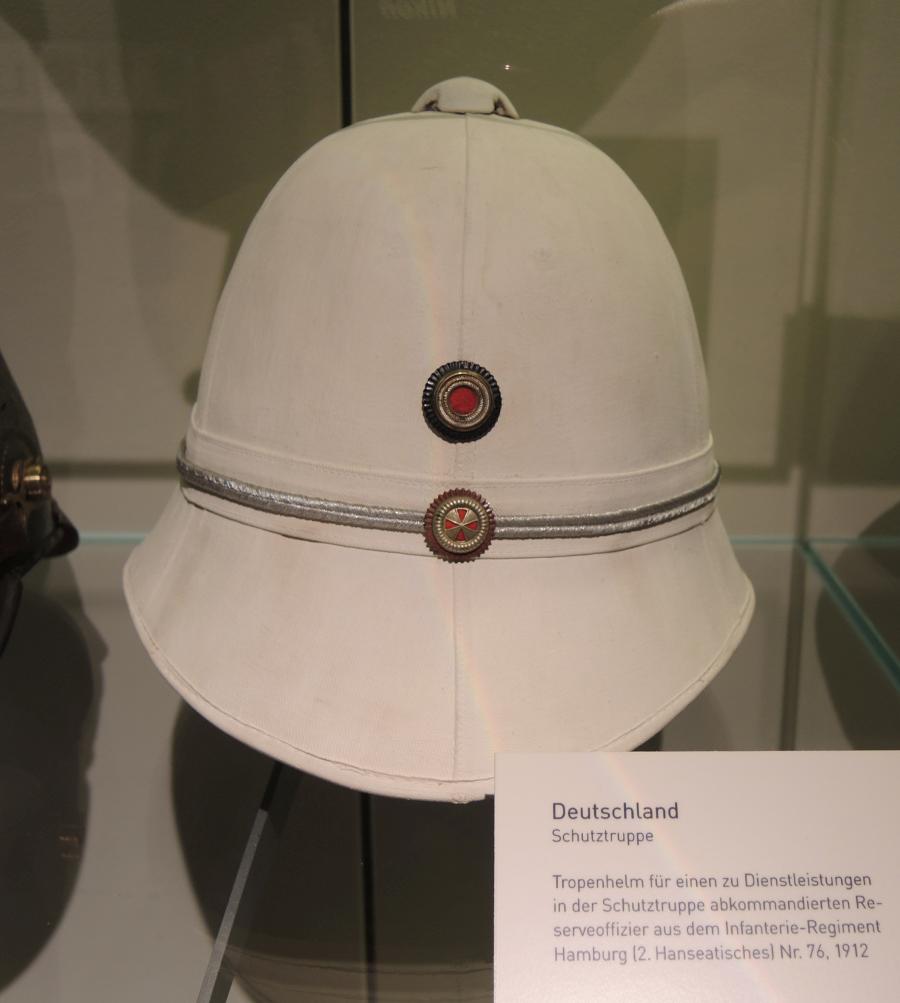
Tropical Helmet for an Officer of the
76th Hamburg Infantry Regiment Seconded to the Schutztruppe
This 1891 model helmet has the silver cords of an officer, an
officers imperial cockade and below it the Hamburg cockade.
.jpg)
Südwester Hat for a Schutztruppe Pharmacist
To denote that the wearer is a pharmacist (in this case an
Oberapoteker), the hat has a crimson hatband and edging and a white metal imperial eagle on
the front. The owner of this hat was a seconded Prussian reserve officer, hence the addition of the Prussian
officers cockade with a reserve cross on it.
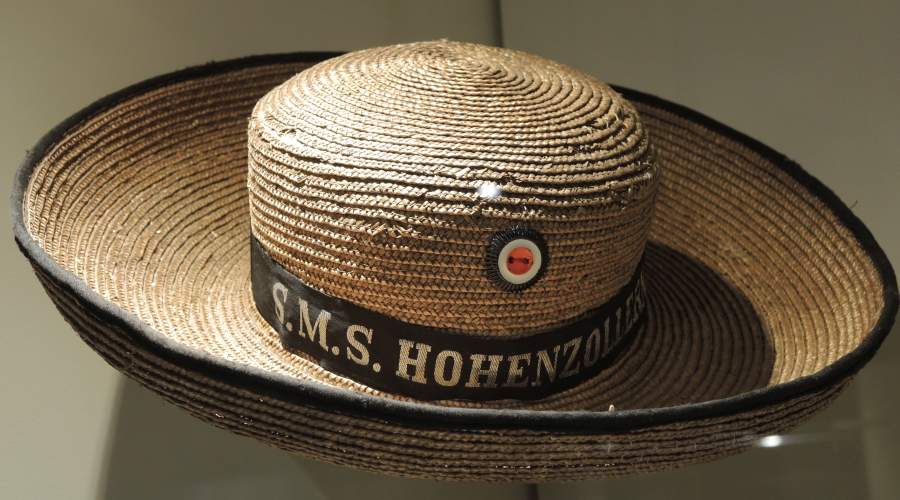
Naval Other Ranks Straw Hat from the SMS
Hohenzollern
It has a small other ranks cockade,
black edging and a tally with "S.M.S. HOHENZOLLERN".
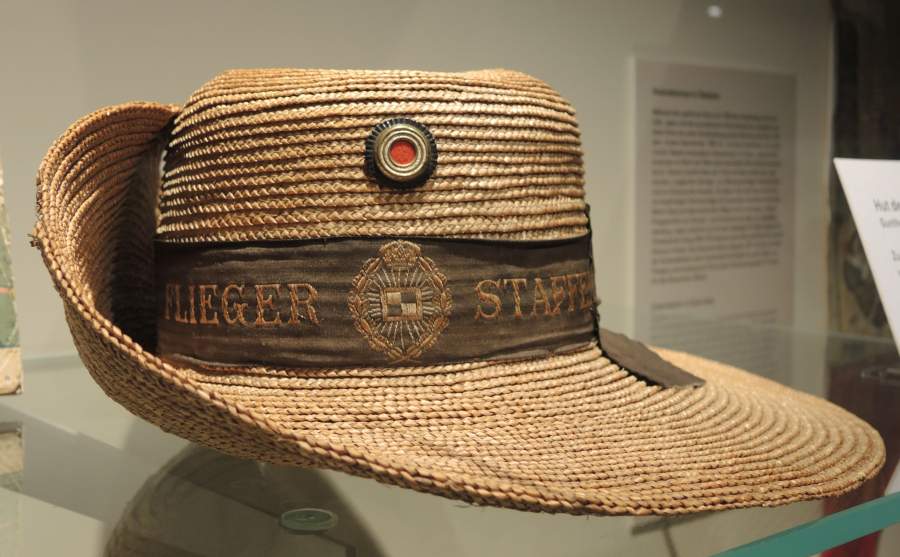
Naval Officers Straw Hat
This hat belonged to
Gunther Plüschow, the only active German pilot at the Siege
of Tsingtao in 1914. It has a small officers cockade and a tally with "FLIEGER
STAFFEL" and the Prussian pilot's award badge in the centre.
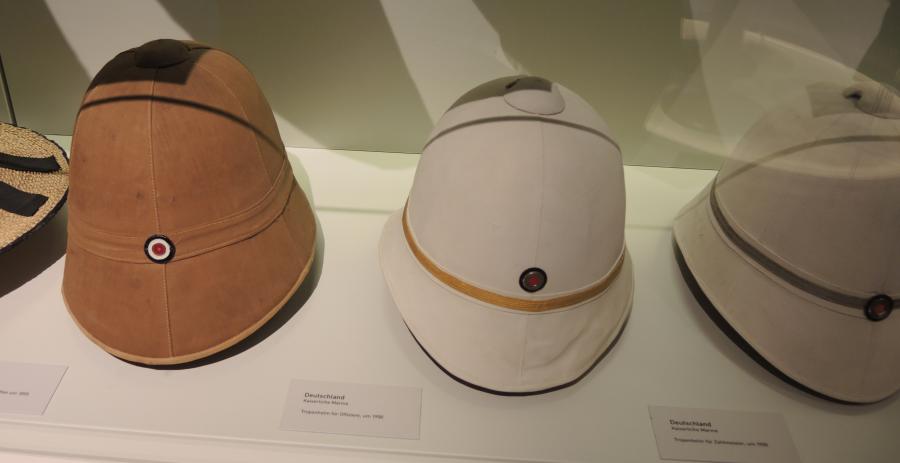
Three Naval Tropical Helmets
On the left is an other ranks 1895 helmet. In the centre is an
officer's 1900 helmet (with gold cords) and on the right a naval
paymaster's helmet (with silver cords).
.jpg)
East Asian Officer's Straw Hat
This is the 1900 straw hat as issued to the original East Asian
Expeditionary Corps in 1900. It has the gold cord around the hatband for
an officer and a large imperial officers cockade above a state cockade.
What makes this hat unique is the state cockade is that of the tiny
Principality of Schwarzburg-Sondershausen (white/blue/white, confusingly
similar to the white/pale blue/white of Bavaria).
Schwarzburg-Sondershausen
only contributed one battalion of infantry to the imperial army, namely
the
I. Battalion of the 71st Thüringian Infantry Regiment. And only one
officer from that battalion served in the East Asian Expeditionary
Corps, thus enabling us to identify this unique hat as belonging to
Leutnant von Stockhausen of the 2nd East Asian Infantry Regiment.
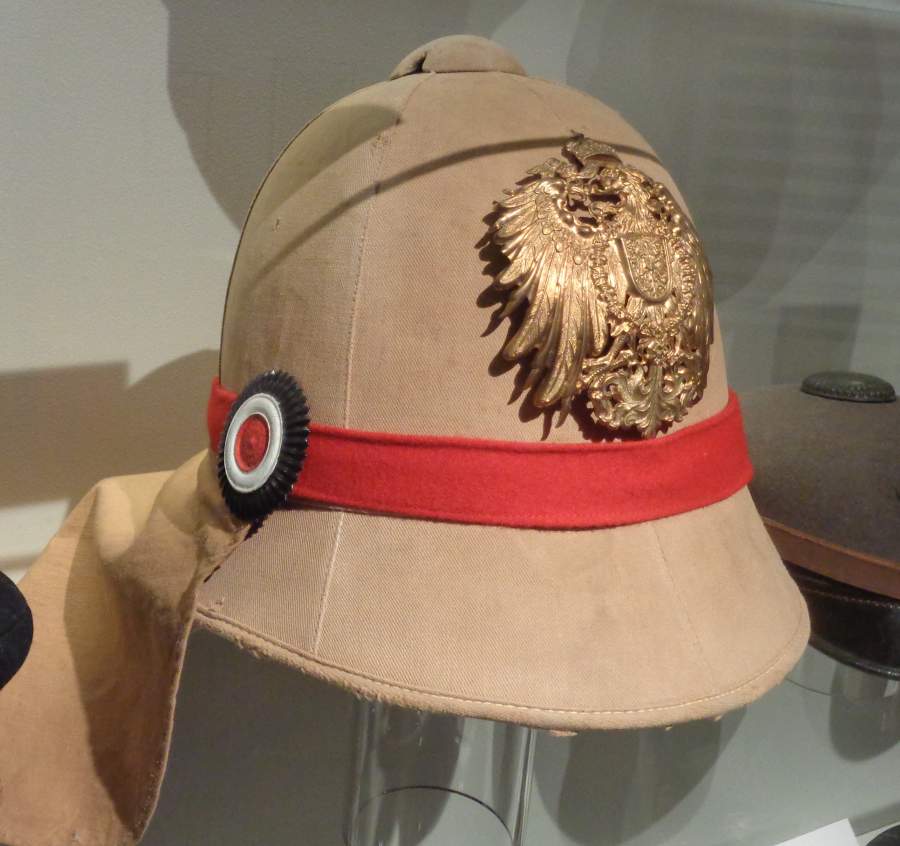
Other Ranks Tropical Helmet for the East
Asian Cavalry
This is a 1900 Bortfeldt tropical helmet in khaki with matching
neckshade. It has a large other ranks cockade on the side, a brass
imperial eagle on the front and a red hatband for cavalry.
.jpg)
Officers Tropical Helmet for the East
Asian Infantry
This is a 1900 Bortfeldt tropical helmet in field grey. It has a
large officers cockade on the side, an imperial eagle on the front and a
white hatband for infantry.
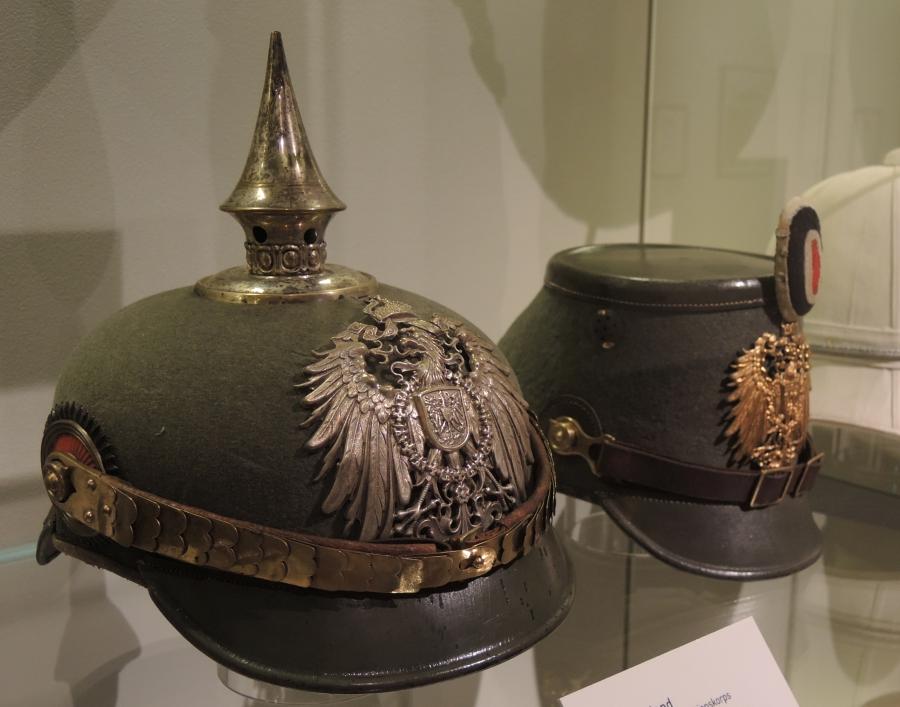
Headdress of the East Asian Occupation
Brigade
On the left is an officer's Pickelhaube from the Pioneer Company
with a white metal eagle, on the right is a similar felt shako from the
East Asian Train Company.

Other Ranks Field Cap of the East Asian
Expeditionary Corps
The khaki peaked cap ("Bordmutze")
was introduced to replace the straw from 12th August 1900 onwards.
Troops going to China from this date onwards (including the 5th and 6th
Infantry Regiments, the Jäger Company, one cavalry squadron, two field
artillery batteries and one heavy artillery battery) were issued the
peaked cap in place of the straw hat and troops already in China
gradually received the replacement cap from there on. The wearer of this
cap was from the 76th Hamburg Infantry Regiment as can be seen from the Hamburg
cockade on the hatband.
.jpg)
Officers Field Cap for the South West
African Schutztruppe
It is made of khaki cloth with a black leather peak, hatband and
piping in blue for South West Africa and an officer's imperial cockade
at the front.
.jpg)
Officers Field Cap for the East African
Schutztruppe
It is made of khaki corduroy with a matching peak. The hatband is
white for East Africa and it has no upper edge piping. On the front is
an officer's imperial cockade at the front.
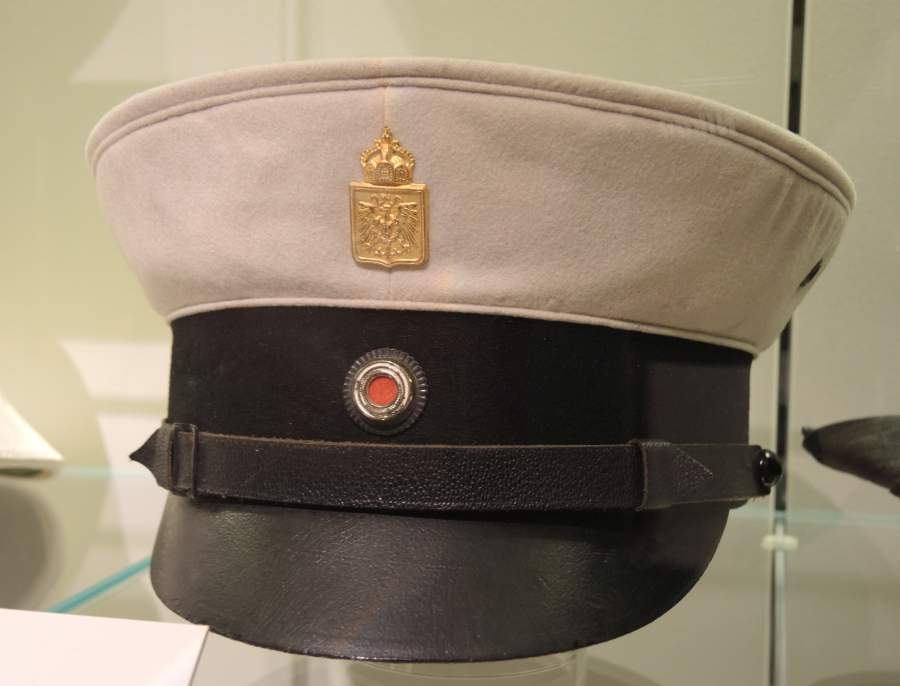
Saddler's Field Cap for the
Schutztruppe
It is made of grey cloth with a black leather peak. The hatband is
black and it has no upper edge piping. On the front is an officer's
imperial cockade and above it a crowned brass shield bearing the
imperial eagle.
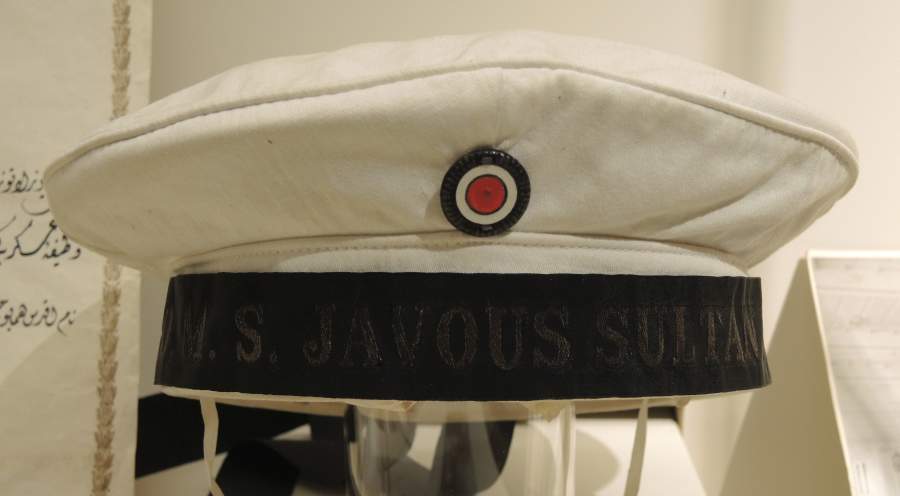
Other Ranks Naval Cap for the SMS Goeben
in Ottoman Service
The cap is a standard German naval white summer cap with black tally and
other ranks imperial cockade at the front. The tally bears the name of
the ship as re-titled when in Turkish service- 'S.K.O.M.S. JAVOUS SULTAN
SELIM I.'.
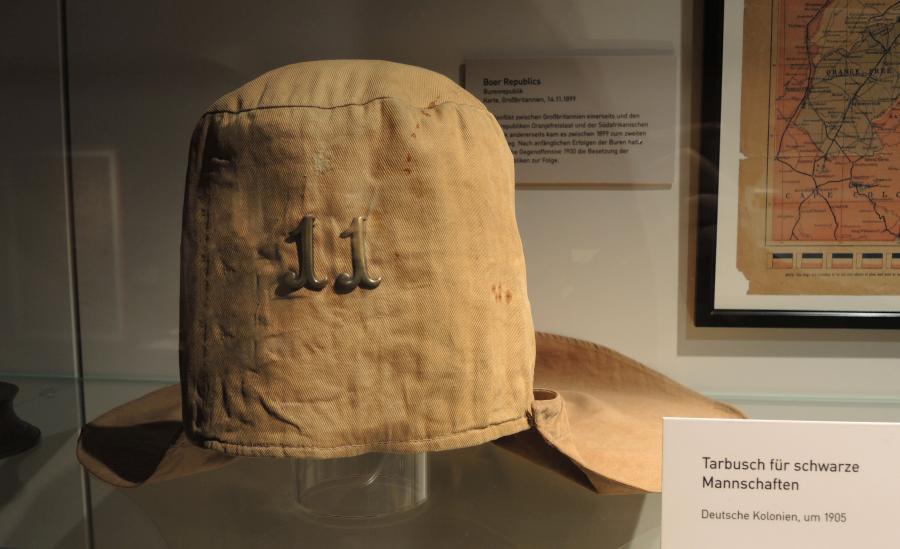
Tarbush for an Askari of the Schutztruppe 11. Feldkompagnie, German East Africa
The Brass numbers were used to identify the different companies of the
East African Schutztruppe. They were gradually replaced from around 1896
by a small white metal imperial eagle.
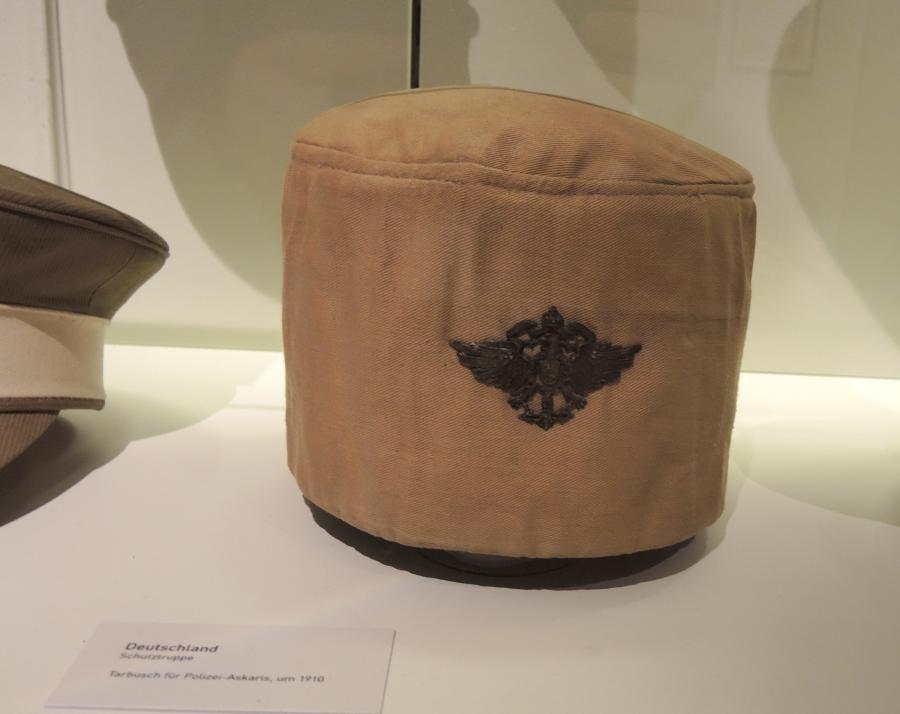
Tarbush for a Polizeitruppe Askari
In khaki cloth with a brass imperial eagle. While the Schutztruppe askaris wore white metal eagles the
Polizeitruppe wore brass eagles as seen here. This eagle is unusually small
for a Polizei-Askari.
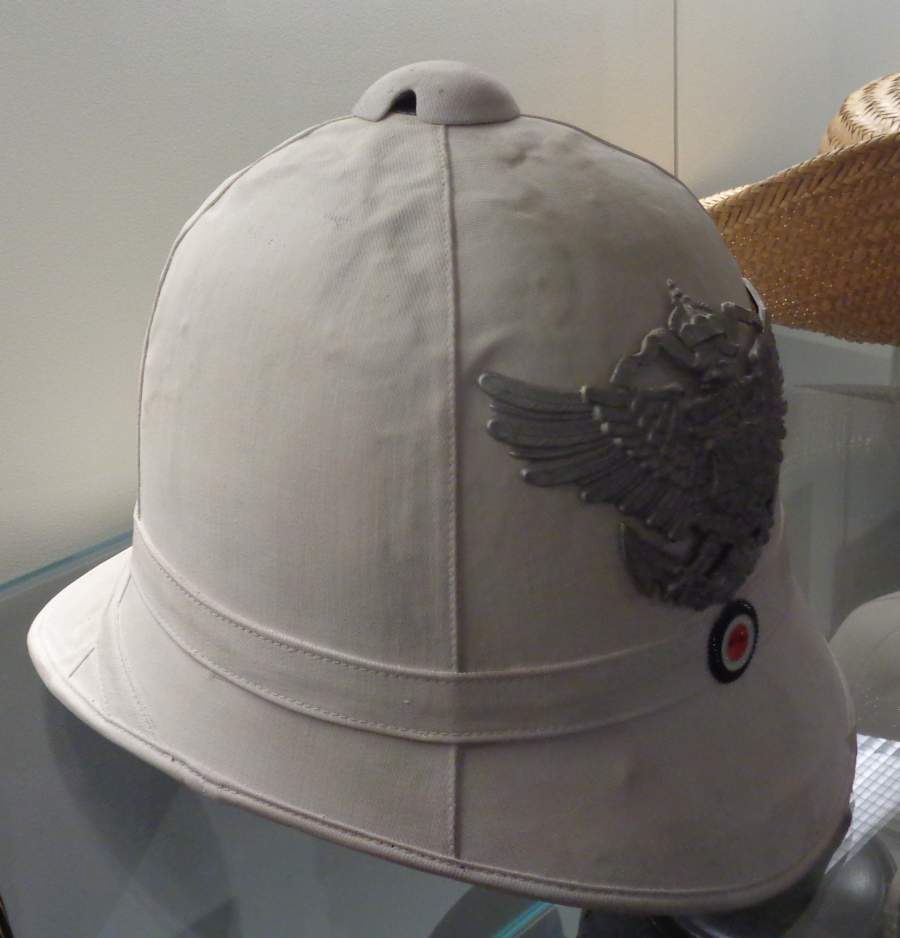
Other Ranks Marine Infantry Tropical
Helmet
This is one of the first tropical helmets issued to the III
Seebataillon in China in 1898. It was made by the Ludwig Bortfeldt
company in white and has a white metal imperial eagle on an anchor.
Later issues were in khaki with brass eagles.
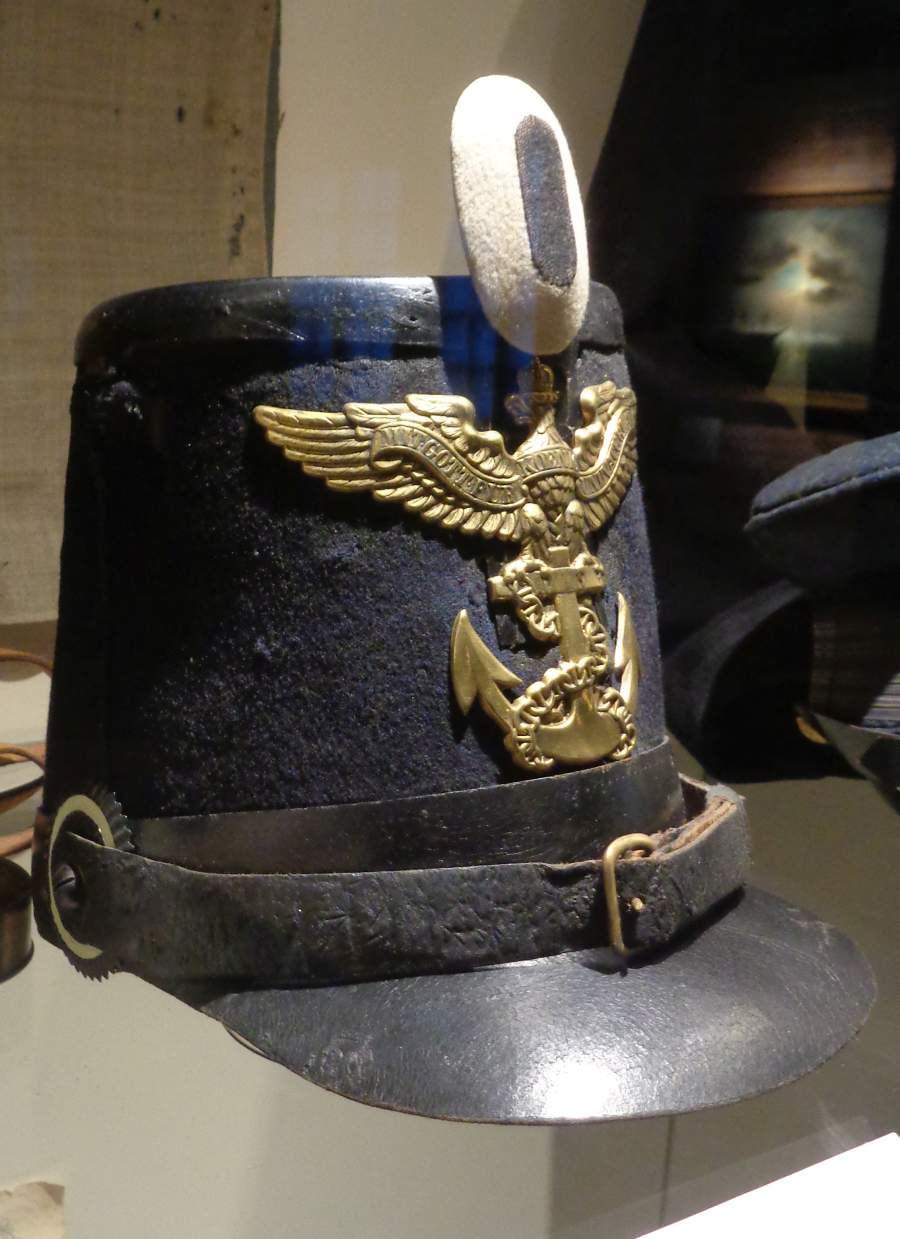
Prussian Seebataillon Tschako
In 1862 the Prussian Seebataillon was authorised to wear an 1860
pattern Jäger style shako in blue-black felt with black leather edging,
peak and chinstrap as seen here. It has a brass Prussian eagle and chained
anchor on the front with a Prussian cockade on the right hand side.

Austro-Hungarian Army Cap worn by the
Marine Detachment Skutari in 1914
This cap was owned by Seesoldat Rau, of the Marine Detachment
Skutari. When the First World War broke out this German unit was
initially put under Austro-Hungarian command and received Austro-Hungarian army
issue caps such as these. It has a brass badge with FJI for Kaiser Franz Josef but has the German
cockade at the front an a strip of red white black colours on the right
hand side.
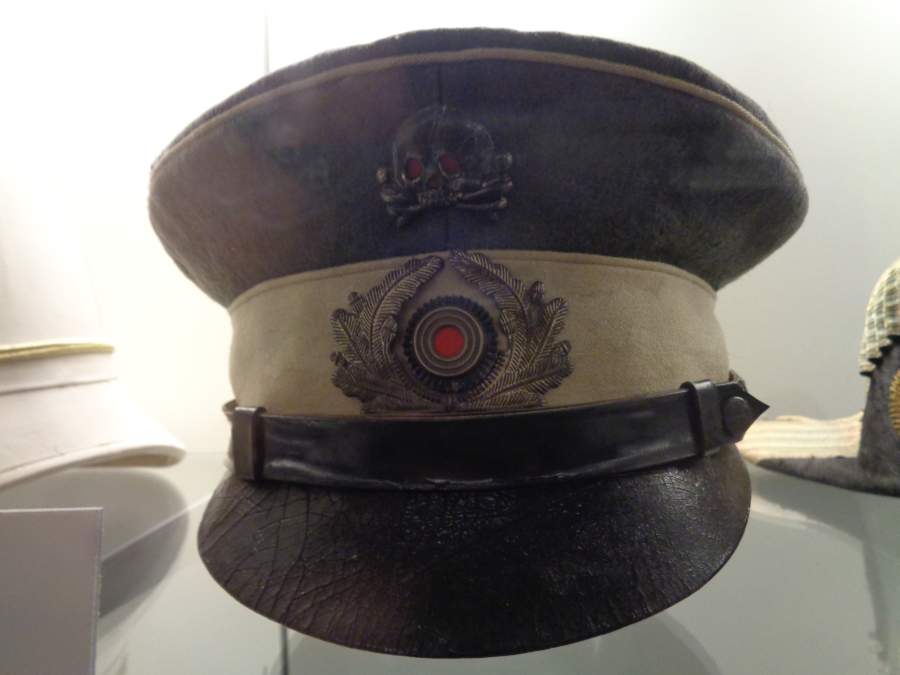
Officer's Field Cap worn by the Freikorps
Schwarze Jäger
The Freikorps Schwarze Jäger were a unit formed mostly from former
Marine Infantrymen during the German Revolution in 1919. This is an
M1910/14 Marine Infantry Officer's cap in field grey with a black
leather peak and chinstrap. Piping and hatband are in white for the
Marine Infantry with an officer's imperial cockade on the hatband in the
centre. Of special interest is the blackened metal Totenkopf badge of
the Freikorps. The red eyes are probably exclusive to officers. The
silver thread wreath around the cockade is a distinction not worn by
Marine Infantry officers but was usually exclusive to officers of the
Imperial Navy.
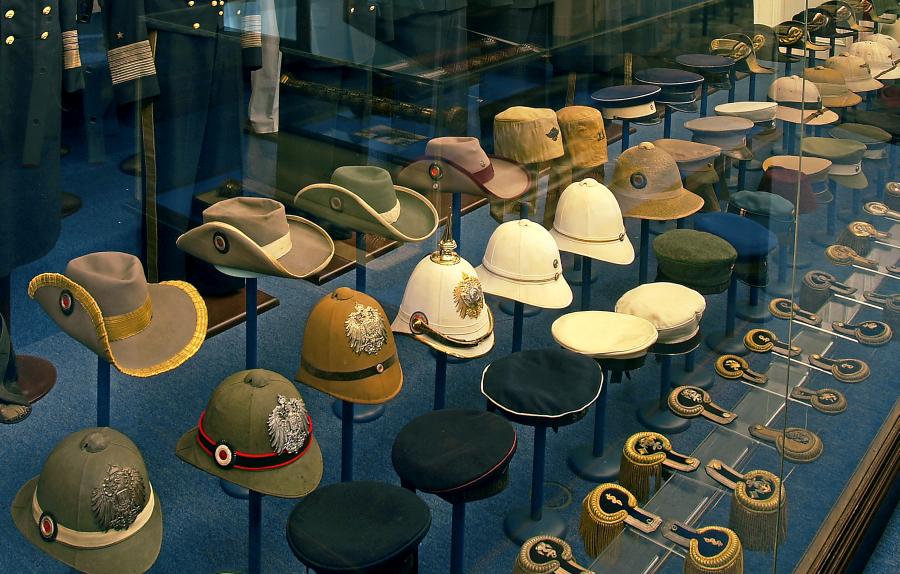
And there's more of this incredible collection of German Colonial and
Overseas headdress
|